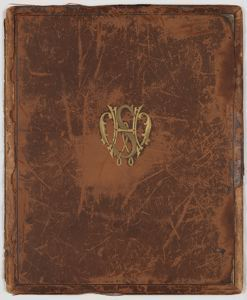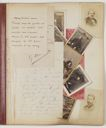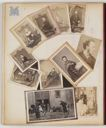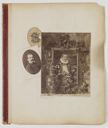
This image is restricted, permission must be requested for reproduction. Downloading for commercial use is prohibited. If you wish to obtain rights to reproduce this image please see our Rights and Reproductions page.
The Stewart Album
1860–90
Pen, ink on letters, cartes de visite and photographic reproductions
20 x 15 in. (50.8 x 38.1 cm)
Century: 19th Century
Credit Line: Meadows Museum, SMU, Dallas. Museum purchase thanks to a gift from the Eugene McDermott Foundation and Ms. Jo Ann Geurin Thetford, MM.2013.02
Accession Number: MM.2013.02
More Information
Gallery Label
“I lost in Mr. Stewart a friend, a protector, and almost a father. He made his house ours, and I owe my position in great part to him. His greatest pleasure was the society of artists, and what I say for myself may be said also for Fortuny, Madrazo, Zamacois, and many others. He was the type of the most perfect caballero which I have ever known, and you need only look at the collection of letters which the artists have written to him to be convinced of this. His gallery of pictures will show the world more than I can say.”
The exhibition The Stewart Album: Art, Letters, and Souvenirs to an American Patron in Paris (http://www.meadowsmuseumdallas.org/about_Stewart.htm) celebrates the Meadows Museum’s recent acquisition of a unique album compiled by the renowned American collector during the latter half of the nineteenth century. Kept in private hands until now, this will be the first time that audiences will have the opportunity to view a significant selection of letters, drawings, and photographs, which belong to this unique album that in total holds 370 photographs (254 portraits and 116 photographic reproductions of works by contemporary artists), six independent drawings, and 193 letters written to Stewart (a handful of them to his wife and two of his sons, Robert and Jules) by many of the most illustrious artists, collectors, aristocracy, and dealers from Europe and the United States.
Over half of these letters were written by artists of the “Modern” Spanish School, among them Martín Rico, Mariano Fortuny y Marsal (1838-1874), Eduardo Zamacois y Zabala (1841-1871), and Raimundo de Madrazo y Garreta (1841-1920). Revealing the esteem to which the American expatriate was held by this group of artists, most of the letters include numerous drawings illustrating stories relating to their personal lives and artistic endeavors. Stewart’s album evidences the major role he played in the lives of these four cosmopolitan Spanish artists, who established successful careers outside Spain and garnered international renown, and who paved the way for future generations of Spanish artists that would do the same in the in the turn of the nineteenth and beginning of the twentieth century. As a whole, the album is a testament to his connoisseurship, taste, and his important place in the international art scene during his time. Among the letters that will be featured in the exhibition are examples by international artists such as Gustave Clarence Rodolphe Boulanger (1824-1888), Jean-Baptiste Édouard Detaille (1848-1912), Jean-Auguste-Dominique Ingres (1780-1867), Jean-Louis Ernest Meissonier (1815-1891), Jehan Georges Vibert (1840-1902), Mihály von Munkácsy (1844-1900), Jules Worms (1832-1914), the American Charles James Theriat (1860-1937), and two examples of letters written by the collector’s own son, who was also an artist, Julius Leblanc Stewart (1855-1919).
Rarely do we encounter such an extraordinary compendium of letters, drawings, and photographs, as the one compiled by William H. Stewart. It is extremely unique, especially when considering the possibility that the influential American collector personally assembled it, a personal document of his life and of the lives of artists working in France during the second half of the nineteenth century. Its uniqueness is highlighted by the fact that it evidences the very close personal relationships that he established with these important artists in his Parisian milieu, especially those of Spanish origin. The collection of primary sources for the history of art included in this album is essential to a better understanding of the history of Spanish art in the second half of the nineteenth century. Through them it is evident that without Stewart’s patronage and unconditional support, these four artists never would have received the international renown they enjoyed, even posthumously. Stewart was an American collector who favored Spanish art and artists, just as Algur H. Meadows was a collector who favored Spanish art and artists. The acquisition of this unique repertoire of letters, drawings, and souvenirs, the Stewart Album strengthens the Meadows Museum’s position as a primary center for the research of Spanish art in the United States.
The exhibition The Stewart Album: Art, Letters, and Souvenirs to an American Patron in Paris (http://www.meadowsmuseumdallas.org/about_Stewart.htm) celebrates the Meadows Museum’s recent acquisition of a unique album compiled by the renowned American collector during the latter half of the nineteenth century. Kept in private hands until now, this will be the first time that audiences will have the opportunity to view a significant selection of letters, drawings, and photographs, which belong to this unique album that in total holds 370 photographs (254 portraits and 116 photographic reproductions of works by contemporary artists), six independent drawings, and 193 letters written to Stewart (a handful of them to his wife and two of his sons, Robert and Jules) by many of the most illustrious artists, collectors, aristocracy, and dealers from Europe and the United States.
Over half of these letters were written by artists of the “Modern” Spanish School, among them Martín Rico, Mariano Fortuny y Marsal (1838-1874), Eduardo Zamacois y Zabala (1841-1871), and Raimundo de Madrazo y Garreta (1841-1920). Revealing the esteem to which the American expatriate was held by this group of artists, most of the letters include numerous drawings illustrating stories relating to their personal lives and artistic endeavors. Stewart’s album evidences the major role he played in the lives of these four cosmopolitan Spanish artists, who established successful careers outside Spain and garnered international renown, and who paved the way for future generations of Spanish artists that would do the same in the in the turn of the nineteenth and beginning of the twentieth century. As a whole, the album is a testament to his connoisseurship, taste, and his important place in the international art scene during his time. Among the letters that will be featured in the exhibition are examples by international artists such as Gustave Clarence Rodolphe Boulanger (1824-1888), Jean-Baptiste Édouard Detaille (1848-1912), Jean-Auguste-Dominique Ingres (1780-1867), Jean-Louis Ernest Meissonier (1815-1891), Jehan Georges Vibert (1840-1902), Mihály von Munkácsy (1844-1900), Jules Worms (1832-1914), the American Charles James Theriat (1860-1937), and two examples of letters written by the collector’s own son, who was also an artist, Julius Leblanc Stewart (1855-1919).
Rarely do we encounter such an extraordinary compendium of letters, drawings, and photographs, as the one compiled by William H. Stewart. It is extremely unique, especially when considering the possibility that the influential American collector personally assembled it, a personal document of his life and of the lives of artists working in France during the second half of the nineteenth century. Its uniqueness is highlighted by the fact that it evidences the very close personal relationships that he established with these important artists in his Parisian milieu, especially those of Spanish origin. The collection of primary sources for the history of art included in this album is essential to a better understanding of the history of Spanish art in the second half of the nineteenth century. Through them it is evident that without Stewart’s patronage and unconditional support, these four artists never would have received the international renown they enjoyed, even posthumously. Stewart was an American collector who favored Spanish art and artists, just as Algur H. Meadows was a collector who favored Spanish art and artists. The acquisition of this unique repertoire of letters, drawings, and souvenirs, the Stewart Album strengthens the Meadows Museum’s position as a primary center for the research of Spanish art in the United States.
Submit comments about this object
Also found in…
first
previous
next
last
record 1 of 1
,
"Objects is "The Stewart Album""
04/04/2025
Bookmark: https://meadowsmuseumdallas.org/collections/pages/objects-1/info/2231













